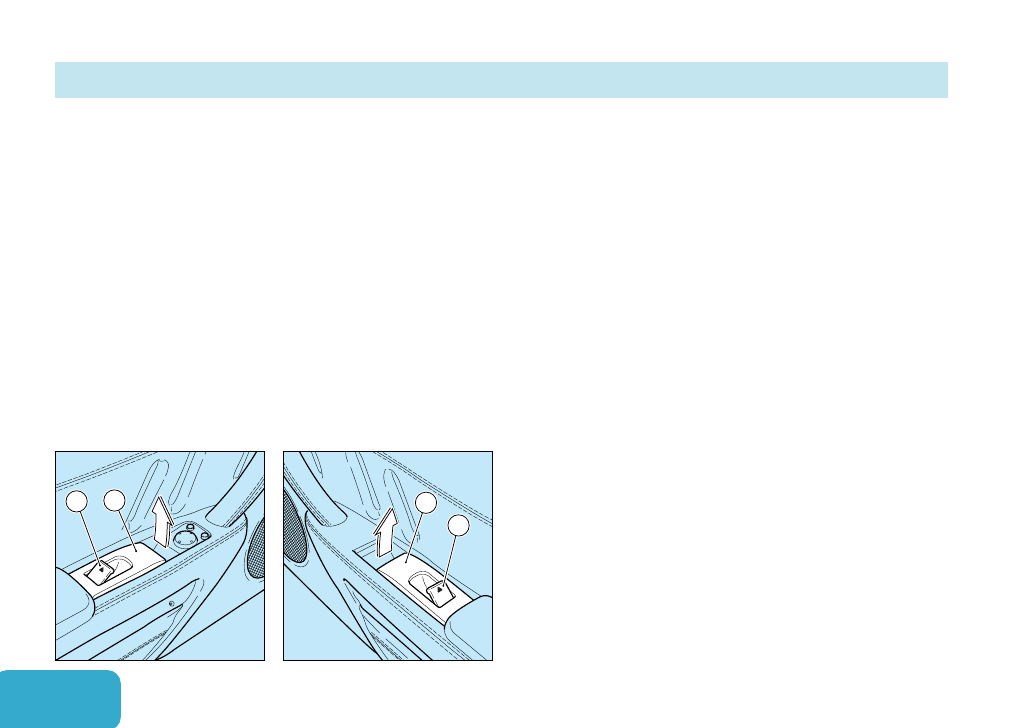Ferrari 575M Maranello (2003 year). Manual - part 4

2
.
26
USO DELLA VETTURA
CONTROLS - RUNNING INSTRUCTIONS
UTILISATION DE LA VOITURE
UTILISACIÓN DEL AUTOMÓVIL
Blocco porte e
apertura dall’interno
Il blocco di entrambe le porte si in-
serisce/disinserisce azionando la
levetta “LOCK” D.
Azionando la maniglia E per aprire
la porta, il cristallo scende a
“traguar-
do”
. Chiudendo la porta, risale fino
al
“tamponamento superiore”
.
Azionando la maniglia E senza pro-
cedere all’apertura, il cristallo scen-
de a
“traguardo”
ma dopo 20 secon-
di, se non si procede all’apertura
della porta, il cristallo risale fino al
“tamponamento superiore”
.
Per aprire la porta occorre quindi ri-
lasciare la maniglia e procedere nuo-
vamente all’azionamento.
Internal door lock and
opening from the inside
The door lock for both doors can be
enabled and disabled using the
small “LOCK” lever D.
When the handle E is used to open
the door, the window will lower to the
“pre-set limit”
. When the door is
closed it will rise to the
“upper thresh-
old”
.
When the handle E is operated with-
out opening the door, the window will
lower to the
“pre-set limit”
. Howev-
er, if the door is not opened within
20 seconds, the window will go back
up to the
“upper threshold”
.
To open the door, release the han-
dle and then open it once again.
Verrouillage des portes et
déverrouillage de l’intérieur
Le verrouillage des deux portes s’ef-
fectue et s’exclue en actionnant le
levier “LOCK” D.
En actionnant le levier E pour ouvrir
la porte, la vitre descend en
“butée
inférieure”
. En verrouillant la porte,
elle remonte jusqu’à la
“butée supé-
rieure”
.
En actionnant le levier E sans ouvrir
la porte, la vitre descend jusqu’en
“butée inférieure”
mais au bout de
20 secondes, si on n’ouvre pas la
porte, la vitre remonte jusqu’en fin
de course supérieure
“butée supé-
rieure”
.
Pour déverrouiller la porte, il faut
donc relâcher le levier puis l’action-
ner de nouveau.
Bloqueo puertas apertura
del Interior
El bloqueo del cierre de las puerta
se activa/desactiva accionando la
palanquita “LOCK” D.
Accionando la manilla E para abrir
la puerta, la ventanilla desciende
hasta el
“límite marcado”
. Al cerrar
la puerta, asciende hasta el
“tope
superior”
.
Accionando la manilla E sin llegar a
abrir la puerta, la ventanilla descien-
de hasta el
“límite marcado”
pero si
después de 20 segundos no se abre
la puerta, la ventanilla sube hasta
el
“tope superior”
.
Para abrir la puerta tendrá que sol-
tar la manilla antes de volver a ac-
cionarla.
LOCK
E
D
LOCK
E
D